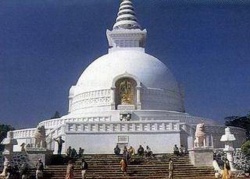Difference between revisions of "Rajagriha"
m (1 revision: Adminos 3 november) |
|
(No difference)
| |
Revision as of 06:00, 3 November 2013
Rajagriha, surrounded by the meandering river Banganga and 5 hills, was known in the past as the abode of kings. During the lifetime of the Buddha this was the capital of the powerful Magadha kingdom, ruled by the virtuous King Bimbisara. The Buddha chose this famous city for many of his retreats and it was here that Devadatta, his jealous cousin, made several attempts on his life. Buddha spent his first rainy season (versa vasa) after enlightenment and third, fourth, seventeenth and twentieth varsaas in Rajgriha. After the parinirvana of Buddha, Ajatasatru enshrined the Buddha’s relics inside a stupa at Rajagriha and, under his patronage, the monks held the First Buddhist Council in the Saptaparni cave.
The hills and caves surrounding Rajagriha were home to spiritual teachers, ranging from the early Charavaka scholars to Upanishadic philosophers.
Like many others in search of truth, Prince Siddhartha, after he renounced his royal heritage, came to this city to seek the path of salvation.
Siddhartha overwhelmed the citizens of Rajagriha with his serenity and grace. Even the king went to meet the ascetic and was amazed to learn that he was a kshatriya of royal descent. King Bimbisara offered half his kingdom to Siddhartha but all he received was an assurance that when Siddhartha achieved his goal he would return to Rajagriha.
The first Buddhist structures at Rajgir were raised when Ajatsatru built a monastery, and a stupa over his share of the Buddha's ashes. That reliquary is now a mound used as a graveyard. The Japanese much later have built the World Peace Stupa, with its gilded images of the Buddha. Rajgir also has the Nipponzan Myohoji, the Japanese temple, and the Centaur Hokke Club which offers some traditional facilities to Japanese pilgrims.
